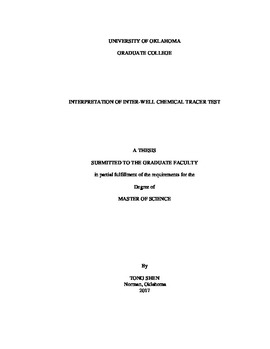| dc.contributor.advisor | Moghanloo, Rouzbeh Ghanbarnezhad | |
| dc.contributor.author | Shen, Tong | |
| dc.date.accessioned | 2017-06-23T13:38:05Z | |
| dc.date.available | 2017-06-23T13:38:05Z | |
| dc.date.issued | 2017 | |
| dc.identifier.uri | https://hdl.handle.net/11244/51705 | |
| dc.description.abstract | For the first time, this thesis presents a new approach to characterize reservoir layering and cross flow between layers using Inter-Well Chemical Tracer Test (ICTT). ICTT is a well-known reliable test for reservoir characterization. During ICTT, a slug of chemical components is injected into subsurface and monitored at producers. Analysis of tracer production history (i.e. tracer produced concentration versus time) provides the reservoir properties. Since reservoirs are usually layered with significant heterogeneity, it is crucial to understand and interpret tracer movement in a stratified system. This study is divided into three parts:
Part1- A comprehensive literature review on inter-well tracer test applications in oil reservoirs is presented. The review includes analytical/numerical methods used to evaluate the results. Limitations and advantages of various evaluation methods are reviewed in detail.
Part2- A new formulation is presented to study tracer propagation along streamlines in heterogeneous reservoirs. The streamlines in this study are modeled as analogous reservoir layers with no cross flow. The fraction of layers where tracer transport occurs faster than the solution of convection–diffusion equation(CDE) is determined; this fraction represents layers through which channeling may take place; obviously, the larger the fraction, the lower the sweep efficiency. Moreover, Ranger field is used to demonstrate how to decouple the convoluted effects of the channeling from small-scale heterogeneity.
Part3- A new formulation is developed to model the crossflow between layers through calculating the dynamic fraction of injected fluid permeating into each layer as a function of time. Previous models fail to detect crossflow between layers. Several numerical simulation and the same field examples are employed to verify the proposed method. A ‘bridge’ is artificially created in numerical simulation to mimic the major crossflow. The simulation results indicate that tracer can be used to detect and evaluate crossflow. The distance between injector and crossflow can significantly change the tracer production history. The field example was based on the ICTT conducted in Ranger Field. We successfully match the field tracer data and our result indicates the existence of crossflow. Identification of crossflow between layers is critical step to understand reservoir complexity and could provide helpful insight for successful enhance oil recovery (EOR) projects. The proposed method can be easily performed in spreadsheet with the limited data. | en_US |
| dc.language | en_US | en_US |
| dc.subject | Energy. | en_US |
| dc.subject | Engineering, Petroleum. | en_US |
| dc.title | INTERPRETATION OF INTER-WELL CHEMICAL TRACER TEST | en_US |
| dc.contributor.committeeMember | Wu, Xingru | |
| dc.contributor.committeeMember | Devegowda, Deepak | |
| dc.date.manuscript | 2017 | |
| dc.thesis.degree | Master of Science | en_US |
| ou.group | Mewbourne College of Earth and Energy::Mewbourne School of Petroleum and Geological Engineering | en_US |
